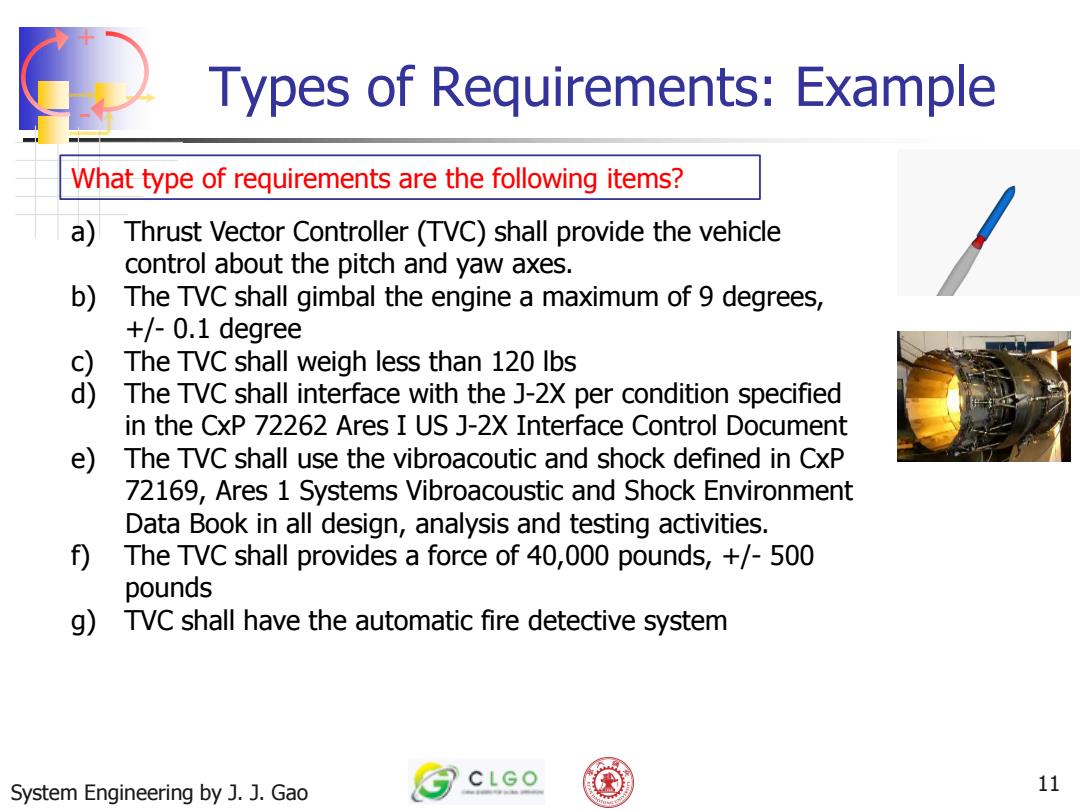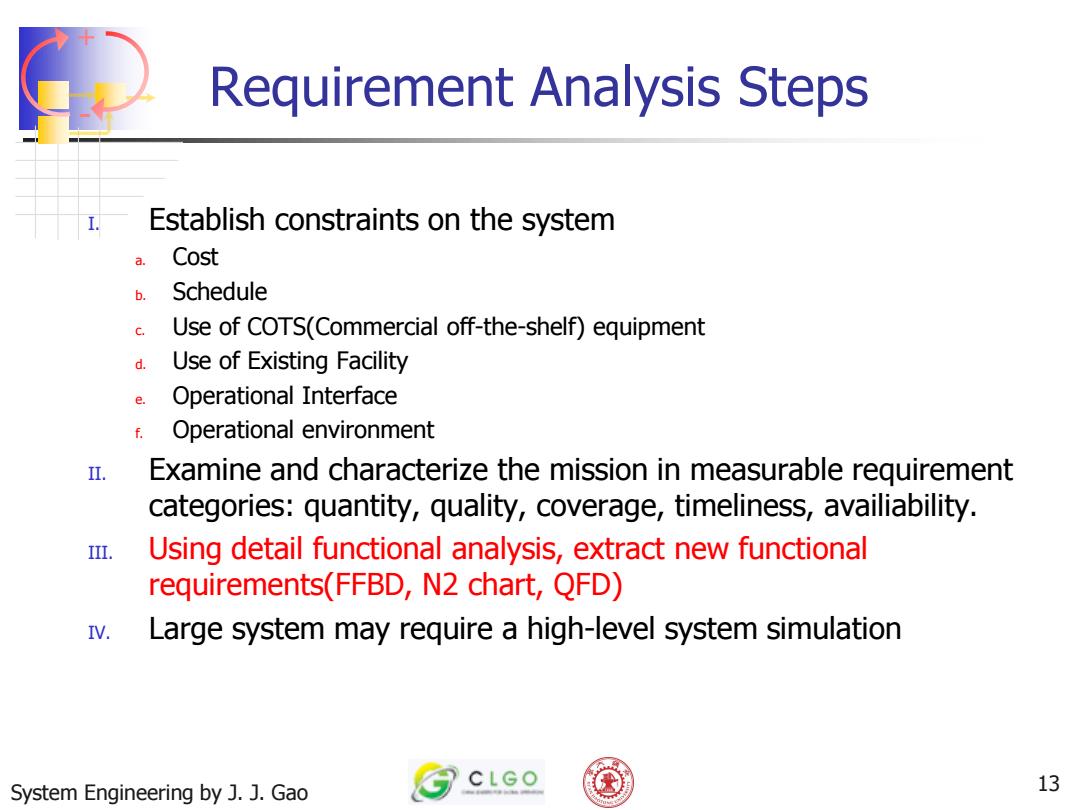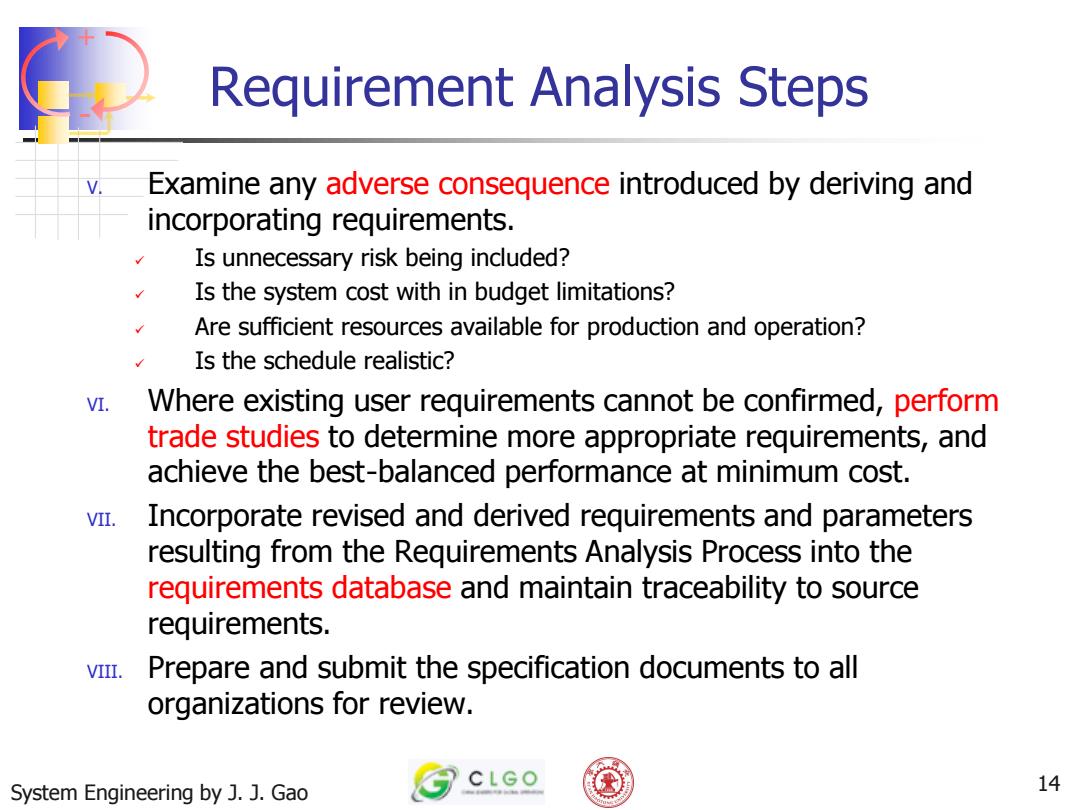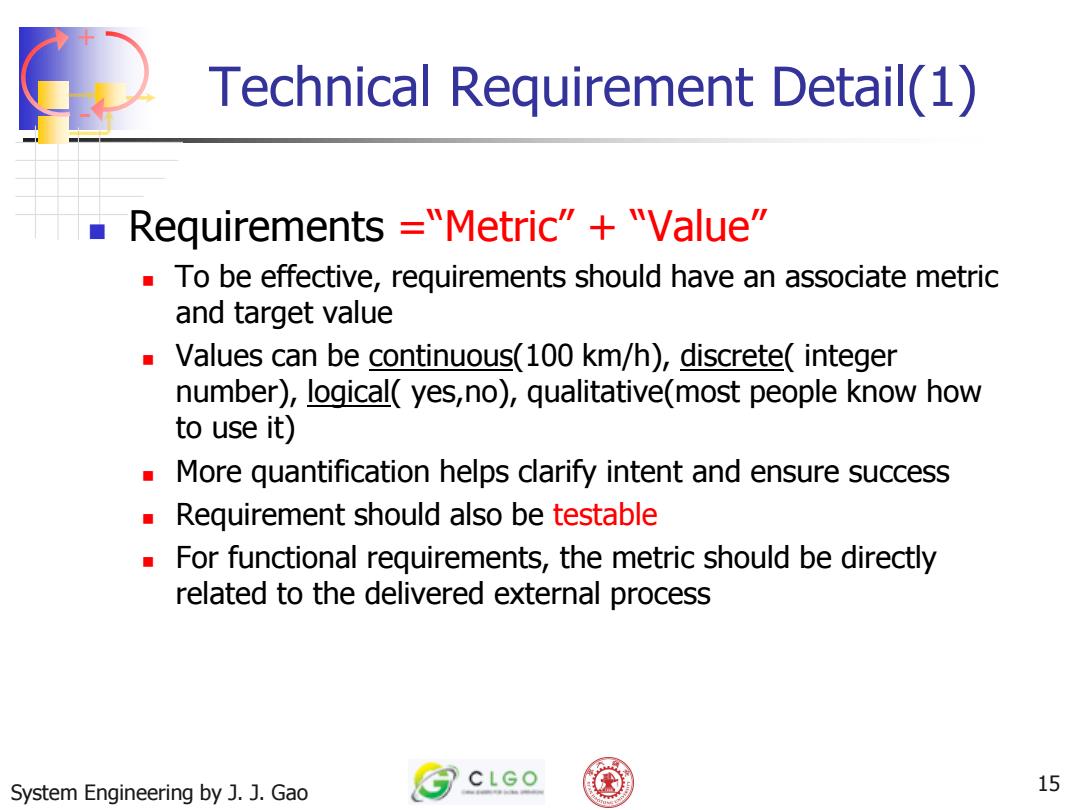
Types of Requirements:Example What type of requirements are the following items? a) Thrust Vector Controller (TVC)shall provide the vehicle control about the pitch and yaw axes. b) The TVC shall gimbal the engine a maximum of 9 degrees, +/-0.1 degree c) The TVC shall weigh less than 120 Ibs d) The TVC shall interface with the J-2X per condition specified in the CxP 72262 Ares I US J-2X Interface Control Document e) The TVC shall use the vibroacoutic and shock defined in CxP 72169,Ares 1 Systems Vibroacoustic and Shock Environment Data Book in all design,analysis and testing activities. ) The TVC shall provides a force of 40,000 pounds,+/-500 pounds g) TVC shall have the automatic fire detective system CLGO System Engineering by J.J.Gao 11
+ - System Engineering by J. J. Gao 11 Types of Requirements: Example a) Thrust Vector Controller (TVC) shall provide the vehicle control about the pitch and yaw axes. b) The TVC shall gimbal the engine a maximum of 9 degrees, +/- 0.1 degree c) The TVC shall weigh less than 120 lbs d) The TVC shall interface with the J-2X per condition specified in the CxP 72262 Ares I US J-2X Interface Control Document e) The TVC shall use the vibroacoutic and shock defined in CxP 72169, Ares 1 Systems Vibroacoustic and Shock Environment Data Book in all design, analysis and testing activities. f) The TVC shall provides a force of 40,000 pounds, +/- 500 pounds g) TVC shall have the automatic fire detective system What type of requirements are the following items?

Requirement Analysis Steps CAPTURE SOURCE REQUIREMENTS REQUIREMENTS AND DESIGN REQUIREMENTS ANALYSIS BASELINE System ENGR Require- ments ESTABLISH MEMOS Documents METRICS ALLOCATED SPEC DERIVED TREE Statement of FUNCTIONAL REQMT Work.WBS ANALYSIS MODELING Compliance Documents REQMTS TRACEABILITY LOWER Standards SIMULATION MATRIX LEVEL SPECS SYSTEM COTS, ARCHITECTURE REQUIREMENTS NDI, IMPACTS DATABASE EXAMINE FACILITIES ADVERSE CONSEQUENCES TRADES DRAFT SPECIFICATION OPERATIONS REVIEW User Needs CONCEPT AUDIT BASELINE User Rea DESIGN DESIGN CONSTRAINTS IDENTIFY TBD/TBR PRIORITIZE PERFORMANCE REQUIREMENTS EVALUATION 1 RELEASED SPECS ICDs INCOSE SE Handbook 2011 CLGO System Engineering by J.J.Gao 12
+ - System Engineering by J. J. Gao 12 Requirement Analysis Steps INCOSE SE Handbook 2011

Requirement Analysis Steps Establish constraints on the system a.Cost b. Schedule Use of COTS(Commercial off-the-shelf)equipment Use of Existing Facility e. Operational Interface Operational environment II. Examine and characterize the mission in measurable requirement categories:quantity,quality,coverage,timeliness,availiability. Using detail functional analysis,extract new functional requirements(FFBD,N2 chart,QFD) IV. Large system may require a high-level system simulation CLGO System Engineering by J.J.Gao 13
+ - I. Establish constraints on the system a. Cost b. Schedule c. Use of COTS(Commercial off-the-shelf) equipment d. Use of Existing Facility e. Operational Interface f. Operational environment II. Examine and characterize the mission in measurable requirement categories: quantity, quality, coverage, timeliness, availiability. III. Using detail functional analysis, extract new functional requirements(FFBD, N2 chart, QFD) IV. Large system may require a high-level system simulation System Engineering by J. J. Gao 13 Requirement Analysis Steps

Requirement Analysis Steps Examine any adverse consequence introduced by deriving and incorporating requirements. Is unnecessary risk being included? Is the system cost with in budget limitations? Are sufficient resources available for production and operation? Is the schedule realistic? VI. Where existing user requirements cannot be confirmed,perform trade studies to determine more appropriate requirements,and achieve the best-balanced performance at minimum cost. VII. Incorporate revised and derived requirements and parameters resulting from the Requirements Analysis Process into the requirements database and maintain traceability to source requirements. VIII. Prepare and submit the specification documents to all organizations for review. CLGO System Engineering by J.J.Gao 14
+ - V. Examine any adverse consequence introduced by deriving and incorporating requirements. Is unnecessary risk being included? Is the system cost with in budget limitations? Are sufficient resources available for production and operation? Is the schedule realistic? VI. Where existing user requirements cannot be confirmed, perform trade studies to determine more appropriate requirements, and achieve the best‐balanced performance at minimum cost. VII. Incorporate revised and derived requirements and parameters resulting from the Requirements Analysis Process into the requirements database and maintain traceability to source requirements. VIII. Prepare and submit the specification documents to all organizations for review. System Engineering by J. J. Gao 14 Requirement Analysis Steps

Technical Requirement Detail(1) Requirements ="Metric"+"Value" To be effective,requirements should have an associate metric and target value Values can be continuous(100 km/h),discrete(integer number),logical(yes,no),qualitative(most people know how to use it) More quantification helps clarify intent and ensure success Requirement should also be testable For functional requirements,the metric should be directly related to the delivered external process CLGO System Engineering by J.J.Gao 15
+ - Requirements =“Metric” + “Value” To be effective, requirements should have an associate metric and target value Values can be continuous(100 km/h), discrete( integer number), logical( yes,no), qualitative(most people know how to use it) More quantification helps clarify intent and ensure success Requirement should also be testable For functional requirements, the metric should be directly related to the delivered external process System Engineering by J. J. Gao 15 Technical Requirement Detail(1)